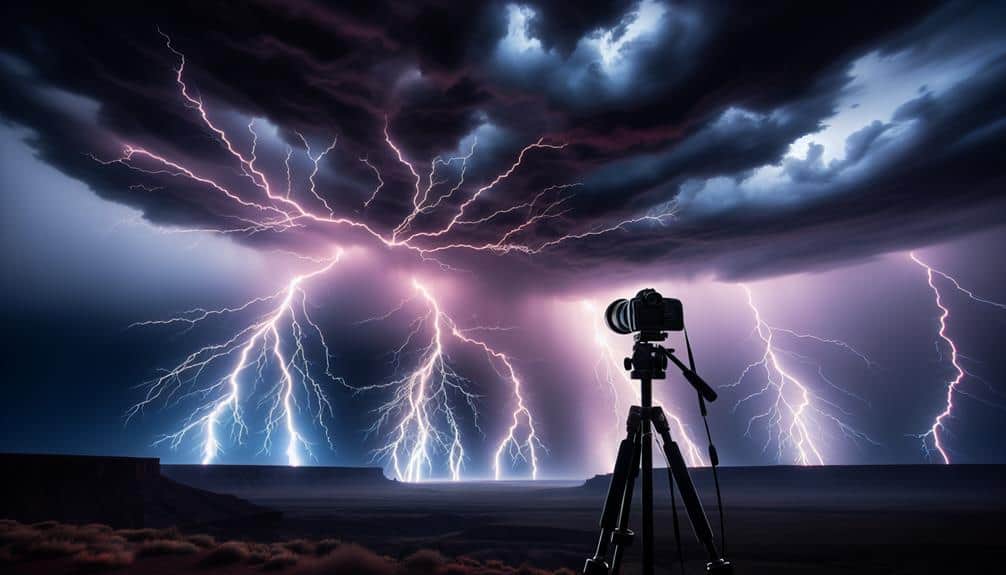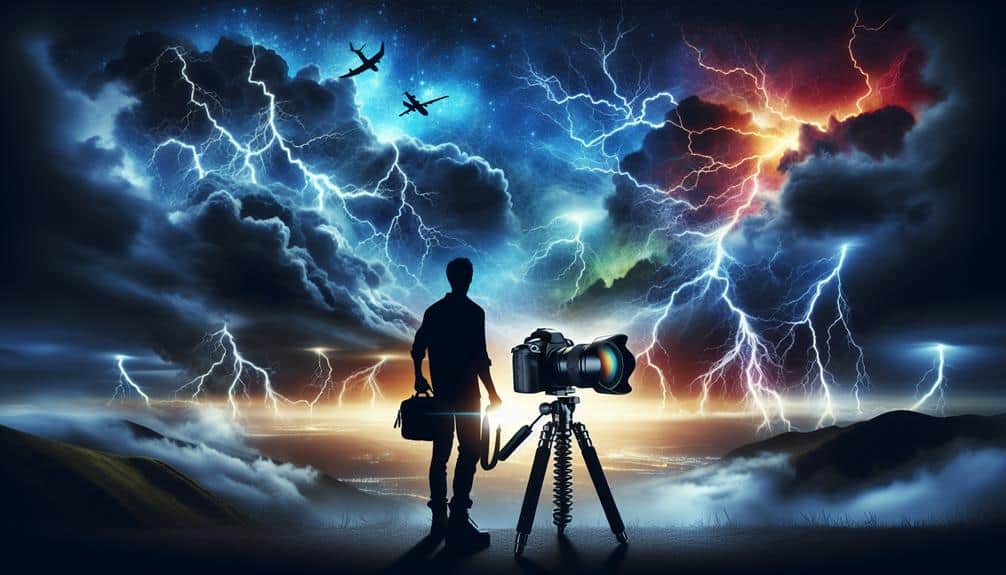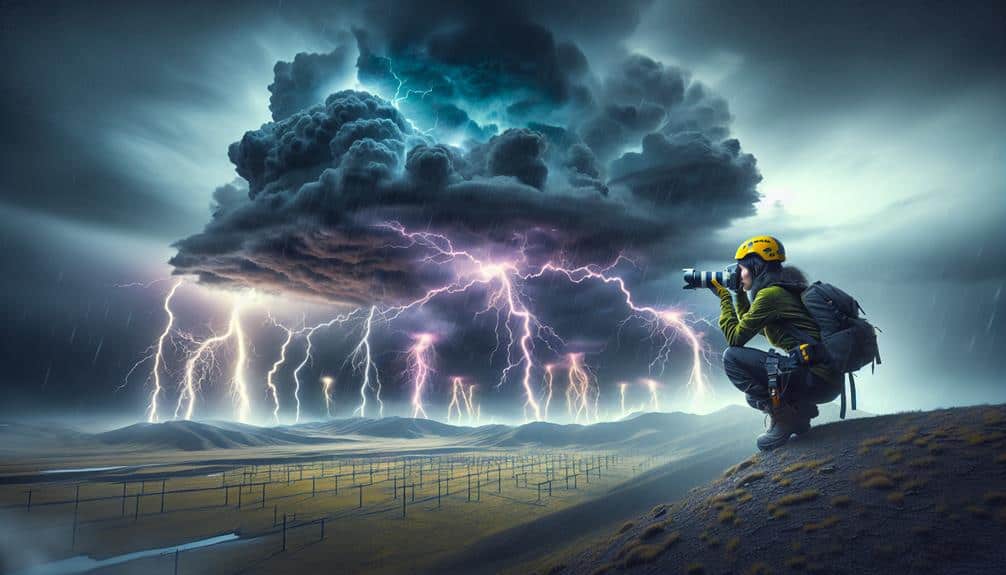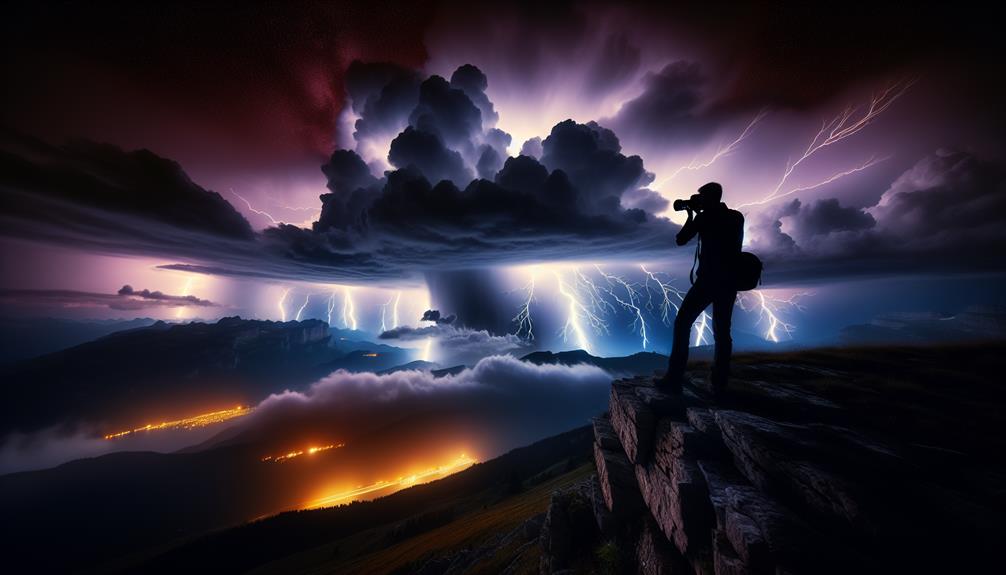We'll optimize our timing for lightning strikes by leveraging weather data, ensuring our equipment is top-notch, and utilizing real-time detection apps. Start by analyzing weather patterns with satellite data and radar to pinpoint storm locations. Equip a high-definition camera and a sturdy tripod to capture clear long-exposure shots, and use lightning triggers for precision. Real-time lightning detection apps blend satellite data with algorithms for accurate predictions, important for situational awareness. Safety measures are vital; always prioritize understanding storm behaviors and seeking shelter if needed. By mastering these techniques, we can greatly enhance our lightning strike timing accuracy.
Key Points
- Monitor real-time lightning detection apps for strike alerts and storm tracking.
- Use high-speed cameras and intervalometers to capture quick succession shots.
- Analyze weather radar data to predict storm cell movements and activity.
- Incorporate advanced storm-chasing techniques for optimal positioning.
Understanding Weather Patterns
To accurately predict lightning strikes, we must first analyze the underlying weather patterns that create the conditions for these electrical discharges. Weather forecasting and storm tracking are essential tools we use to monitor and predict atmospheric conditions. By examining data from satellites, radar, and ground-based sensors, we can detect the development of thunderstorms and identify the potential for lightning activity.
Understanding atmospheric conditions is pivotal for predicting lightning behavior. Key factors include temperature, humidity, and wind patterns, which contribute to the instability in the atmosphere required for thunderstorm formation. When warm, moist air rises and cools, it can form cumulonimbus clouds, the primary breeding ground for lightning. By tracking these atmospheric changes, we can anticipate areas where lightning is likely to occur.
Additionally, storm tracking allows us to monitor the movement and intensity of thunderstorms in real-time. This involves analyzing radar imagery and lightning detection networks to pinpoint where lightning strikes are happening and where they might occur next. Accurate weather forecasting models incorporate these data points to provide precise predictions on lightning behavior.
Choosing the Right Equipment
Selecting the appropriate equipment for lightning detection and prediction hinges on understanding the specific requirements of our monitoring objectives. We need tools that guarantee high equipment reliability to capture precise data. For lightning photography, reliability is paramount. Cameras with robust sensors capable of long exposures are essential. We should opt for DSLR or mirrorless cameras with high-resolution capabilities, as they provide the clarity needed to capture lightning's intricate details.
In addition to the camera, a sturdy tripod is non-negotiable. It minimizes vibrations, ensuring our long-exposure shots remain crisp. Lightning triggers, which detect flashes and automatically release the shutter, increase the probability of capturing lightning strikes. These devices need to be highly sensitive and fast, as lightning is unpredictable and fleeting.
To enhance our setup, we should consider weatherproof gear. Lightning events often coincide with severe weather conditions, and our equipment must withstand these elements to maintain functionality. A dependable weather app or a portable lightning detector can provide real-time data, aiding in our decision-making process and positioning.
The integration of these components guarantees our lightning photography is both effective and efficient, offering us the freedom to capture nature's spectacle with precision.
Setting Up Your Camera
To effectively capture lightning strikes, we must focus on selecting the right gear and optimizing our camera settings. Utilizing a DSLR with a fast shutter speed and a tripod for stability is essential.
Additionally, setting the aperture between f/8 and f/16 and adjusting the ISO to a low value, such as 100 or 200, will yield the best results.
Choosing the Right Gear
We must prioritize using a DSLR or mirrorless camera with manual settings to capture the precise moment of a lightning strike. These cameras offer the necessary flexibility and control over exposure, shutter speed, and aperture, which are essential for capturing fast, unpredictable events like lightning.
Proper gear maintenance is also crucial. Regularly clean your camera sensor and lenses to guarantee optimal image quality and prevent any dust or debris from ruining your shots.
Weather conditions play a significant role in our preparation. Before heading out, we should always check the latest weather forecasts and radar data. This allows us to anticipate storm patterns and position ourselves strategically.
Carrying a sturdy tripod is non-negotiable; it stabilizes the camera during long exposures, reducing the risk of motion blur. Additionally, using a remote shutter release minimizes camera shake, which is important for sharp images.
Investing in a weather-sealed camera and lens can protect our gear from the elements, ensuring longevity and reliability. Remember, safety is paramount. Always maintain a safe distance from the storm and avoid setting up near tall structures or open fields.
Optimal Camera Settings
Optimizing our camera settings is important to successfully capturing the fleeting brilliance of a lightning strike.
Let's focus on exposure settings first. We need a small aperture, typically between f/8 and f/16, to ensure a large depth of field, which helps in capturing the entire scene sharply. A low ISO setting, ideally around 100 to 200, minimizes noise, essential for high-quality images. Our shutter speed should be long, ranging from 10 to 30 seconds, to increase the chances of capturing a strike within a single frame.
Considering focus tips, manual focus is necessary. Autofocus can struggle in low light conditions, leading to missed opportunities. We should pre-focus on a distant object, then switch to manual focus to lock it in place.
Lighting conditions and angle selection play important roles too. Shooting during twilight provides a balanced exposure, capturing both the lightning and surrounding landscape. The angle selection involves positioning ourselves at a safe distance with an unobstructed view of the storm. A wide-angle lens, around 24mm to 35mm, allows us to frame more of the sky and increases the likelihood of capturing a strike.
Using Lightning Detection Apps
Let's analyze how lightning detection apps provide real-time strike alerts, focusing on their accuracy and user interface.
We'll compare data from multiple apps to determine which offers the most precise information.
Our goal is to identify the most reliable tools for timely and user-friendly lightning detection.
Real-Time Strike Alerts
With the advent of sophisticated lightning detection apps, users can now receive real-time strike alerts with remarkable accuracy and speed. This technological advancement greatly enhances our lightning safety measures. Utilizing a blend of satellite data, ground-based sensors, and advanced algorithms, these apps provide precise strike prediction, offering us the freedom to make informed decisions quickly.
Real-time strike alerts are vital for both personal safety and operational planning. When a lightning detection app sends an alert, it's not just a notification; it's a data-driven warning that can save lives and prevent property damage. The app's interface often displays the distance of the nearest strike, allowing us to gauge the immediate threat level.
Additionally, some apps feature predictive modeling that estimates the storm's path, giving us a crucial edge in anticipating weather changes.
App Accuracy Comparison
To evaluate the effectiveness of these real-time strike alerts, we must analyze the accuracy of various lightning detection apps through a thorough comparison of their data sources, algorithms, and prediction capabilities.
When app reliability is considered, we first look at the data sources each app utilizes. Some apps depend on satellite data, others on ground-based sensors, and some on a hybrid approach. Apps using a hybrid model typically show improved accuracy due to the inclusive nature of their data inputs.
Next, we examine the algorithms driving strike prediction accuracy. Machine learning algorithms, especially those trained on extensive historical data, tend to outperform simpler heuristic models. These advanced algorithms can recognize intricate patterns and provide more precise predictions, enhancing overall app reliability.
Lastly, we must scrutinize each app's strike prediction accuracy by comparing their real-time alerts against verified lightning strike events. Apps demonstrating a high correlation between predicted and actual strikes are considered more dependable.
For freedom-seekers who venture into the great outdoors, selecting an app with a proven track record of high accuracy and reliability is essential. By thoroughly analyzing these factors, we can identify the most trustworthy lightning detection apps, empowering us to make informed decisions and stay safe.
User Interface Ease
How effectively can we navigate and interpret the interface of lightning detection apps to guarantee timely and accurate strike alerts? User interface ease is vital, especially when precision and speed are paramount. To maximize our storm tracking capabilities, we need apps that offer intuitive dashboards and clear visualizations. Data latency should be minimal, ensuring real-time updates for immediate action.
For those of us involved in lightning photography, the app's interface must provide granular details like strike distance, intensity, and frequency. A cluttered interface can be detrimental, hindering our ability to capture that perfect shot. We benefit from customizable alerts that allow us to set specific parameters for notifications, ensuring we get the information we need without unnecessary noise.
Moreover, we should prioritize apps that integrate seamlessly with GPS for precise location-based alerts. This feature enhances our storm tracking by offering localized data, which is vital for both safety and best photographic opportunities. Analytical tools within the app, such as historical strike data and predictive modeling, can offer deeper insights and improve our planning and responsiveness.
Perfecting Your Timing

Mastering the exact moment to capture a lightning strike hinges on understanding and predicting the intricate patterns of storm activity. In our pursuit of excellence in lightning photography, we need to incorporate advanced storm chasing techniques. By analyzing weather radar data and storm cell movements, we can anticipate the exact locations where lightning is most likely to occur. This involves interpreting meteorological data such as wind speed, humidity, and atmospheric pressure with a sharp analytical eye.
We should prioritize using high-speed cameras and intervalometers to maximize our chances of capturing those fleeting moments. Timing our shots accurately often means setting our cameras to continuous shooting mode and utilizing long exposures. The best settings generally include a low ISO to reduce noise and a small aperture to maximize a deep depth of field, enhancing image clarity.
Moreover, leveraging real-time lightning detection networks can provide us with precise data on lightning strikes, allowing us to adjust our positions and camera settings dynamically.
Safety Precautions
Securing our safety while capturing lightning photographs demands a meticulous understanding of storm behavior and a strict adherence to best practices. We need to prioritize lightning safety and awareness by keeping a close eye on weather reports and real-time radar data. This data-driven approach helps us predict the storm's path and intensity, allowing us to choose appropriate locations and times for our shoots.
When the storm hits, we should never overlook emergency shelters. Structures like vehicles with hard tops or sturdy buildings can offer essential protection. Remember, if we hear thunder, we're within striking distance and must take immediate precautions. Staying clear of open fields, tall trees, and bodies of water minimizes our risk of being struck.
In addition, utilizing lightning detection apps enhances our situational awareness by providing alerts on nearby strikes. These tools allow us to make informed decisions about when to seek shelter.
Frequently Asked Questions
How Can I Predict the Duration of a Lightning Storm?
We can predict a storm's duration by analyzing lightning patterns and using advanced forecasting models. Accurate storm duration forecasting allows for better preparation and minimizes risks, helping us maintain our freedom during severe weather events.
What Is the Best Time of Day to Photograph Lightning?
The prime time to photograph lightning is during the golden hour or late night. Ideal weather conditions and advanced capturing techniques enhance image quality. Data shows increased lightning activity during these periods, providing more opportunities for stunning shots.
Can I Capture Lightning Strikes With a Smartphone Camera?
Can we capture lightning strikes with a smartphone camera? Absolutely, though smartphone limitations make it challenging. Adjusting camera settings like ISO and shutter speed can help, but don't expect DSLR-level results. It's possible with patience and practice.
How Do I Minimize Noise in Long-Exposure Lightning Photos?
To minimize noise in long-exposure lightning photos, we should optimize our camera settings by using a low ISO and appropriate exposure time. Post-processing noise reduction techniques further enhance image quality, providing us with greater creative freedom.
What Are Common Mistakes to Avoid When Photographing Lightning?
When photographing lightning, we often overlook best camera settings and composition tips. We sometimes neglect safety precautions and equipment recommendations too. Ensuring proper settings and gear maximizes safety and captures stunning, precise lightning shots effectively.


